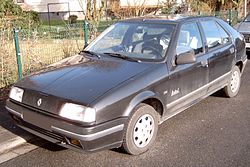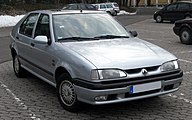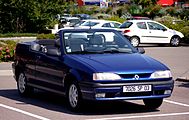Renault 19
| Renault | |
|---|---|
|
Renault 19 five-door (1988-1992)
|
|
| 19th | |
| Production period: | 1988–1997 ( Turkey : until 2003) |
| Class : | Compact class |
| Body versions : | Station wagon , sedan , convertible |
| Engines: |
Otto engines : 1.4–1.8 liters (43–99 kW) Diesel engines : 1.9 liters (47–66 kW) |
| Length: | 4156-4248 mm |
| Width: | 1694 mm |
| Height: | 1412 mm |
| Wheelbase : | 2545 mm |
| Empty weight : | 975-1175 kg |
| Previous model | Renault 9/11 |
| successor | Renault Mégane I |
The Renault 19 (short- R19 ) is a car of the compact class of Renault . The model was produced from mid-1988 to early 1997. Its engine has four cylinders and is installed across the front in line with the gearbox. It drives the front wheels, which are individually suspended from wishbones and MacPherson struts . The rear wheels are individually on parallel swing suspended. They sit with their torsion bar springs on a subframe . The brake works with disc brakes at the front and drum brakes at the rear, the steering with pinion and rack .
history
The first development work on the Renault 19 began in November 1983, with Jacques Cheinisse as project manager. Under the code X-53 there were other code names depending on the model type of the R19: B53 for the five-door, C53 for the three-door, L53 for the Chamade and D53 for the convertible.
After eight months, the body shape was fixed and after thirteen months the interior. Up until April 1986, the interior was repeatedly adapted and test vehicles drove around 7.5 million kilometers.
In June 1988 Renault officially presented the Renault 19. Sales in France started on September 5, 1988 and in Germany on January 19, 1989.
With the appearance of the R19, the predecessors Renault 9 and Renault 11 were no longer produced from December 1988. In September 1989, the notchback sedan followed with the addition of the name Chamade (in German: Herzflimmern ).
The convertible was developed by Karmann in Germany on behalf of Renault and manufactured in the Rheine plant from mid-1991 . The production time for a vehicle including safety and quality checks was around 16 hours.
With the help of aerodynamic experiments, the designer Giorgio Giugiaro designed a shape with low air resistance. The grill is only hinted at between the headlights and the exterior mirrors are aerodynamically designed. The rain strips on the roof were omitted. The vehicle had a drag coefficient (c w ) of 0.31; the 16V sports variant with a rear spoiler, which was sold from autumn 1990, reached 0.30.
The vehicles were produced in Europe from mid-1988 to early 1997 on modernized production lines in Douai and Maubeuge (France), Valladolid (Spain) and Setúbal (Portugal). Until 2000, the Renault 19 was also built in Santa Isabel (Brazil) and in Córdoba (Argentina) for the Latin American market.
From 1990 to 1994 the Renault 19 was the best-selling import car in Germany and was sold almost 100,000 times in 1991 (97,262) and 1992 (97,086). In the years that followed, these figures were not even remotely matched by any other import car (for comparison: the Škoda Octavia , the best-selling imported car in 2005, was only sold 51,015 times). It wasn't until 2009 that the Škoda Fabia - thanks to the scrapping bonus - achieved an even higher number of registrations in one calendar year, with 103,645 units sold.
A total of over 460,000 copies of the R19 were sold in Germany alone during its construction period. Together with the Clio , which appeared in June 1990, it was the pillar of Renault's upswing in the early 1990s. The R19 was also a success in the new federal states and was at times the best-selling car behind the Opel Kadett - even before the VW Golf . The R19 was the last Renault model to have a number as a name.
Facelift
In April 1992 the R19 underwent a comprehensive facelift . Typical for Renault, these vehicles are known as phase 2 for the revised models . From then on, the notchback bore the addition of Bellevue .
The model series was produced in Europe until autumn 1995 and was replaced by the Mégane as the successor. After production in Europe ended, it was manufactured in Argentina and Turkey until 2000.
After the hatchback and notchback production ended, the open version was renamed Renault Cabriolet and production continued until the beginning of 1997.
Weak points
Known weaknesses in the body are the rear wheel arches of the hatchback and notchback models and the front edge of the hood of the models after the revision in spring 1992.
The models with gasoline engines are not E10 compatible.
Engines
| Petrol engines | |||||||||
|---|---|---|---|---|---|---|---|---|---|
| model | Versions | Displacement | Maximum power | Max. Torque | Mixture preparation | Engine code | 0-100 km / h | V max | Construction period |
| 1.2 | RL, RN, RT | 1171 cc | 43 kW (58 hp) at 6000 min -1 | 85 Nm at 4000 min -1 | injection | E7F | 155 km / h | 04 / 1992-10 / 1995 | |
| 1.4 | 1397 cc | 44 kW (60 hp) at 5250 min -1 | 101 Nm at 2750 min -1 | Carburetor | C1J | 05 / 1988-12 / 1989 | |||
| TR, GTR, RL, RN | 1390 cm³ | 43 kW (58 hp) at 4750 min -1 | 100 Nm at 3000 min -1 | injection | C3J | 14.8 s | 161 km / h | 01 / 1989-10 / 1995 | |
| TS, GTS, TSE | 59 kW (80 hp) at 5750 min -1 | 108 Nm at 2750 min -1 | Carburetor | E6J | 13.0 s | 176 km / h | 05 / 1988-12 / 1989 1 | ||
| RL, RN | 58 kW (79 hp) at 6000 min -1 | 107 Nm at 3500 min -1 | injection | E7J | 12.2 s | 173 km / h | 11 / 1993-10 / 1995 | ||
| 1.7 | TS, GTS, TSE | 1721 cc | 55 kW (75 hp) at 5000 min -1 | 125 Nm at 3250 min -1 | Carburetor | F2N | 09 / 1988-12 / 1989 1 | ||
| GTX, TXE | 68 kW (92 hp) at 5750 min -1 | 138 Nm at 3000 min -1 | 11.0 s | 183 km / h | |||||
| GTS, TSE | 54 kW (73 hp) at 5000 min -1 | 127 Nm at 2750 min -1 | injection | F3N-L-740 | 12.3 s | 171 km / h | 10 / 1989-10 / 1995 | ||
| TXE | 66 kW (90 hp) at 5250 min -1 | 140 Nm at 3000 min -1 | F3N-N-742 | 10.7 s | 185 km / h | 09 / 1988-02 / 1997 | |||
| TXI | 79 kW (107 hp) at 5800 min -1 | 151 Nm at 4000 min -1 | F3N | 10.9 s | 190 km / h | 06 / 1990-04 / 1992 | |||
| 1.8s | RT | 1794 cc | 65 kW (88 hp) at 5750 min -1 | 142 Nm at 2750 min -1 | injection | F3P | 10.9 s | 181 km / h | 04 / 1992-05 / 1994 |
| 1783 cc | 66 kW (90 hp) at 5750 min -1 | 144 Nm at 2750 min -1 | 05 / 1994-02 / 1997 | ||||||
| 1.8i | RT | 1794 cc | 80 kW (109 hp) at 5500 min -1 | 160 Nm at 4250 min -1 | injection | F3P 700 | 8.7 s | 198 km / h | 04 / 1992-05 / 1994 |
| 1783 cc | 79 kW (107 hp) at 5500 min -1 | 158 Nm at 4250 min -1 | F3P 682 | 05 / 1994-02 / 1997 | |||||
| 16V | 16V | 1764 cc | 99 kW (135 hp) at 6500 min -1 | 158 Nm at 4250 min -1 | injection | F7P 704 | 9.5 s | 208 km / h | 06 / 1990-02 / 1997 |
| Diesel engines | |||||||||
| model | Versions | Displacement | Maximum power | Max. Torque | Mixture preparation | Engine code | 0-100 km / h | V max | Construction period |
| 1.9d | TD, GTD, TDE, RL, RN, RT | 1870 cc | 47 kW (64 hp) at 4500 min -1 | 118 Nm at 2250 min -1 | Swirl chamber injection | F8Q | 15.7 s | 161 km / h | 09 / 1988-10 / 1995 |
| 1.9dT | Turbo D, Turbo DX, RN, RT | 1870 cc | 66 kW (90 hp) at 4250 min -1 | 175 Nm at 2250 min -1 | Swirl chamber injection | F8QT | 11.4 s | 183 km / h | 09 / 1990-10 / 1995 |
safety
In 1992, auto motor und sport subjected the Renault 19 together with six other compact class models to an offset crash test with 50% overlap and an impact speed of 55 km / h. The Renault 19 performed worse than VW Golf III and Opel Astra F and better than Citroën ZX , Seat Toledo , Ford Escort '91 and Fiat Tipo .
The Technical University of Berlin in 2007 undertook a crash-test comparison between a Renault 19 Phase 2 without belt tensioners and airbags and a Renault Megane II through to demonstrate the development of the motor vehicle safety over the past 10 years. The vehicles were driven head-on against a rigid wall at a speed of 50 km / h. Due to an error in the implementation of the test, belt tensioners and airbags in the Renault Mégane II did not trigger, which resulted in higher loads on the dummies than in the Renault 19. This was justified with the higher structural rigidity of the Mégane and the “softer” belts due to active belt force limiters that work purely mechanically and are therefore independent of the activation state of the airbag .
According to the final report of the Federal Office of Economics and Export Control , 13,281 Renault 19s were scrapped in favor of the environmental bonus between January 27, 2009 and July 31, 2010.
Awards
- 1989: "Car of the Year" in Germany and Spain
- 1990: “Car of the Year” in Ireland and Denmark
- 1992: " The Golden Steering Wheel " (class 2)
- 1993: "Car of the Year" in Argentina
Web links
Individual evidence
- ↑ http://maybach300c.blogspot.com/2012/08/16-front-wheel-drive.html
- ↑ a b c d e Renault Deutschland AG (Ed.): RHOMBUS . Magazine of the Federal Association of German Alpine and Renault Clubs. No. 2/2013 , 2013, p. 153 ( www-renault-club.de ).
- ↑ Renault model type overview on Mobilverzeichnis.de (accessed on December 31, 2013)
- ↑ General facts about Renault 19 in the Renault World Wiki (accessed December 31, 2013)
- ^ Hans-Ulrich Büschi: Automobile Revue 1991 . Ed .: Hallwag AG. Switzerland 1991, ISBN 3-444-00514-8 , p. 509 .
- ↑ History of Renault 19 on Renault19world.de (accessed on December 31, 2013)
- ↑ About Renault 19 on Auto-Motor-Und-Sport.de (accessed on December 31, 2013)
- ↑ Data on the Renault 19 on Autobild.de (accessed on December 31, 2013)
- ↑ Renault R 19 on Im-Auto.de (accessed on December 31, 2013)
- ↑ List of Renault car models not suitable for E10
- ↑ Gert Hack: Crash Course. auto motor und sport, issue 6/1992, accessed on July 21, 2014 .
- ↑ Heiko Johannsen: Crash tests for the 100th anniversary of the motor vehicles department at the TU Berlin. Technical University of Berlin, Institute for Land and Sea Transport (ILS), Department of Motor Vehicles, October 19, 2007, archived from the original on October 18, 2014 ; Retrieved October 19, 2014 .
- ↑ Final report - environmental bonus. (PDF; 1.6 MB) Federal Office for Economics and Export Control and Federal Motor Transport Authority, November 1, 2010, accessed on July 21, 2014 .
- ^ The winners of the Golden Steering Wheel (1976–2013). (PDF) In: The Golden Steering Wheel 2013 - Press Kit - Axel Springer. Bild am Sonntag and Auto Bild , November 12, 2013, p. 19 , accessed on October 19, 2014 .









